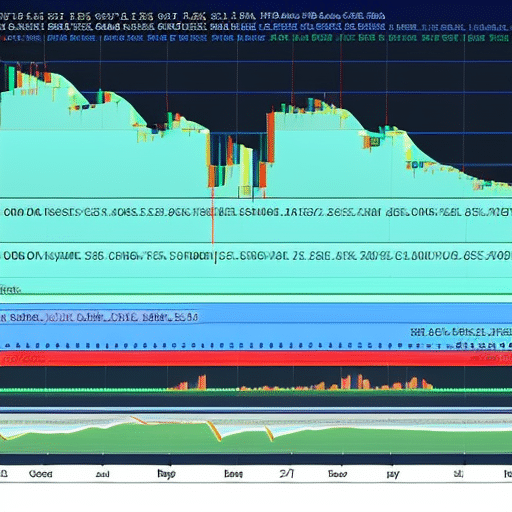Xrp Ecosystem Expansion
XRP has been making waves in the crypto-sphere with its rapid growth and potential for large-scale expansion. Like a snowball rolling downhill, it is quickly becoming an integral part of the global financial system. As the ecosystem expands, more and more people are gaining access to its powerful features, which are revolutionizing the way money moves around the world. This article will explore how XRP is driving this transformation by examining RippleNet and XRP-powered solutions, applications, regulations, compliance, adoption rates and future prospects. With all these elements coming together like pieces of a puzzle, it’s clear that XRP is poised to become an essential tool for anyone interested in quickly moving funds securely across borders.
Overview of XRP
XRP is a digital asset and cryptocurrency created by Ripple Labs, Inc. in 2012 with the purpose of enabling faster, cheaper international payments. It is an open source payment protocol that allows users to transfer money through the Ripple Network without any third-party intermediary. XRP has scalability options that allow for high throughput and fast settlement times, making it an attractive choice for global payments and money transfers. Furthermore, XRP transactions are near instantaneous with low transaction fees compared to traditional payment networks such as SWIFT or ACH. By leveraging its blockchain technology, XRP can be used to facilitate cross-border payments more efficiently than existing methods while providing improved security and transparency of these transactions. With its vast potential, expansion of the XRP ecosystem can offer numerous benefits to users from increased liquidity to enhanced functionality.
Benefits of XRP Ecosystem Expansion
The expansion of the XRP ecosystem provides numerous benefits, including increased efficiency, lower costs, and improved security. The use of distributed ledger technology allows for faster and more secure payments compared to traditional methods. Additionally, the utilization of this technology reduces operational costs associated with cross-border transactions which makes this system an attractive proposition for businesses looking to maximize their profits. Finally, improved security is ensured through the use of cryptographic algorithms that protect assets and confidential data from malicious actors.
Increased Efficiency
Adoption of XRP has led to increased efficiency in financial transactions. RippleNet, the distributed ledger technology behind XRP, is able to process 1,500 transactions per second with low latency and scalability. This allows for faster transfers between two parties and reduces the overhead involved in manual processing. Moreover, users can track payments real-time using a secure infrastructure that provides visibility into each transaction’s status. Some of the benefits of this improved efficiency include:
- Reduced overhead costs due to automation
- Faster transfer times between two banks or other institutions
- Highly secure infrastructure with visibility into payment statuses
These advantages have been instrumental in increasing adoption of XRP amongst financial organizations around the world as they strive for greater operational efficiencies. As XRP continues to gain traction, it will become even more efficient with further advancements in its underlying technology. This increased efficiency translates into lower costs and better service for customers.
Lower Costs
The adoption of XRP has led to lower costs for users due to its faster transaction processing and scalability. By reducing fees associated with traditional payment networks, XRP helps businesses save money when sending or receiving payments. In addition, the improved scalability of the XRP network allows users to process large volumes of transactions quickly and efficiently, which can lead to significant cost savings in comparison to other networks. The increased efficiency also results in fewer manual interventions required by financial institutions, allowing them to reduce their operating costs further. These benefits have made XRP an attractive option for businesses looking for cost-effective payment solutions.
The enhanced security features provided by XRP also contribute to lower costs for businesses as they are better protected from data breaches and fraudulent activities. The combination of lower fees and improved security makes XRP a great choice for businesses seeking a reliable yet cost-effective payment system. With these advantages, more companies are expected to join the growing XRP ecosystem, further driving down costs by increasing competition within the market. This will ultimately benefit all stakeholders involved in the transaction process as they will be able to enjoy more competitive rates and improved services.
Improved Security
By utilizing sophisticated cryptographic algorithms, XRP offers improved security compared to other payment networks, ensuring users of a secure and reliable transaction process. This is seen through features such as:
- Real-time tracking – this allows for the real-time tracking of payments across the network, reducing the likelihood of fraud or misappropriated funds.
- Decentralized governance – XRP has a decentralized system in place that ensures users are protected from malicious actors and fraudulent activities.
- Improved scalability – with its decentralized architecture, XRP can process millions of transactions per second with minimal latency.
- Robust security protocols – robust security protocols are put in place to ensure user data is kept safe and secure at all times.
The improved security offered by XRP makes it an attractive option for businesses looking to streamline their payment processing operations and reduce costs associated with payment processing fees. By providing a secure platform to transact on, XRP provides businesses with peace of mind when it comes to their financial dealings. With these improved security measures in place, RippleNet and XRP-powered solutions can help companies create more efficient payment systems while increasing customer satisfaction levels.
RippleNet and XRP-Powered Solutions
Utilizing RippleNet and XRP-Powered Solutions, businesses can benefit from faster, more reliable international payments. Built on a decentralized network of financial institutions and powered by the XRP Ledger, RippleNet offers instant payments that are secure and cost-effective compared to traditional payment methods. This allows businesses to access new markets quickly and efficiently with lower costs. Additionally, RippleNet provides access to revolutionary technology such as decentralized finance (DeFi) applications which allow customers to move money around the world in real time without relying on intermediaries.
The table below outlines some of the key benefits of using XRP-powered solutions:
| Benefit | Description |
|---|---|
| Instant Payments | Payments can be sent and received instantly with no need for intermediaries or third parties |
| Lower Fees | Fees are much lower than those associated with traditional payments systems |
| Access to New Markets | Companies can easily access new markets with minimal effort or cost involved |
| Decentralized Finance Applications | Customers have access to DeFi applications that enable them to move money around the world in real time without relying on intermediaries. |
With these benefits, businesses are able to take advantage of RippleNet’s fast, secure, and low-cost international payment solutions while also accessing innovative technologies like DeFi applications. This makes it easier for companies to expand their operations globally while reducing costs and risk. Moreover, this enables them to offer better services at more competitive prices than ever before. As a result, XRP-powered solutions offer organizations an effective way to grow their business in today’s global marketplace.
XRP-Powered Applications
XRP-powered solutions have enabled RippleNet to expand its global reach, providing real-time payments across the world. In addition to RippleNet’s capabilities, XRP-powered applications have been developed, making use of XRP as a store of value and a bridge currency. These applications provide new opportunities for businesses to make use of blockchain technology in order to execute fast and secure transactions on a global scale.
One example is the money transfer application built by SBI Holdings Inc., which enables users to send digital currencies instantly at any time through mobile phones or computers without having to exchange into fiat currency or other forms of money. This application has been used by banks to streamline their payment processes while expanding their customer base. Additionally, various exchanges have adopted XRP as a trading pair, allowing customers from different countries around the world to access liquidity with low cost and less volatility than other cryptocurrencies. The combination of these features provides an environment where XRP can flourish, creating an ecosystem that offers both efficiency and scalability for businesses seeking faster payments on a global level. With this expansion in place, attention now turns towards the growth of XRP in the future.
The Growth of XRP
The recent growth of XRP has demonstrated its potential to revolutionize payments on a global scale, offering businesses faster and more cost-effective transactions. For example, RippleNet’s MoneyTap application allows users in Japan to transfer money instantly within seconds, eliminating the need for time-consuming paper transfers. Ripple has also played an important role in promoting financial inclusion by providing access to banking services for people who may not have had them before. This includes initiatives such as SBI Remit’s Pay Directions that allows customers to send funds overseas from Japan without having a bank account.
In addition, XRP is increasingly being adopted as a payment option by major companies all over the world. This demonstrates strong confidence in the technology and its ability to enable fast and secure payments with minimal fees. Furthermore, Ripple is engaging with regulators across multiple jurisdictions to ensure compliance with applicable laws and regulations while still allowing innovation around cross-border payments. With these efforts, XRP is poised for even greater growth in the years ahead.
Regulation and Compliance
Ripple is actively engaging with regulators across multiple jurisdictions to ensure regulatory compliance while allowing for innovation in the area of cross-border payments. Achieving this goal requires Ripple to meet the compliance requirements of various global financial institutions, governments, and other stakeholders. To do so, Ripple has implemented a comprehensive suite of tools and systems designed to track transactions, detect suspicious activity, and adhere to applicable laws and regulations.
| Global Adoption | Compliance Requirements |
|---|---|
| Financial Institutions | KYC & AML Laws |
| Governments | Tax & Licensing Rules |
| Other Stakeholders | Data Privacy Regulations |
By taking steps towards meeting relevant regulatory standards, Ripple has been able to increase its global adoption as more entities become comfortable working with XRP. This increased adoption has allowed XRP to expand its reach beyond the traditional banking system into new markets around the world. As a result, Ripple’s vision for an efficient global payment system is becoming increasingly more achievable. With these efforts in place, XRP is well-positioned for continued growth and development in the years ahead.
Adoption of XRP
The regulation and compliance of XRP is essential for its success, as it provides stakeholders with a sense of security. Now that the legalities surrounding XRP are in place, attention turns to adoption. The goal of XRP’s adoption is to make cryptocurrency accessible by providing no fee transactions and interoperability solutions. This has been greatly beneficial for many businesses looking for an efficient way to send money internationally without incurring high fees or running into scalability issues. For example, RippleNet allows users to transfer funds quickly and securely without dealing with complicated banking systems. Additionally, RippleNet provides real-time tracking so users can see where their payment is every step of the way. These features have made XRP appealing to many individuals and companies alike.
XRP is also gaining traction amongst financial institutions due to its fast transaction times and low fees compared to other cryptocurrencies on the market. Additionally, Ripple Labs has partnered with several banks around the world which has helped increase awareness about cryptocurrency as well as allowing more people access to XRP services such as cross-border payments. As more organizations continue adopting XRP, this will further expand its reach and help further establish it as a viable currency in both the digital finance space as well as traditional banking systems across the globe. With increased adoption comes improved usability making it easier for individuals and businesses alike to take advantage of all that XRP has to offer, thus setting up a promising future for this digital asset within the global economy.
Future of XRP Ecosystem Expansion
As XRP continues to gain traction, its future prospects for growing into a larger ecosystem are becoming clearer. With an ever-increasing global usage, XRP is well-positioned to become the leading digital asset in terms of market capitalization and trading volume. This has been made possible through the strategic partnerships that Ripple (the company behind XRP) has established with various financial institutions, allowing them access to fast and cost-effective cross-border payments.
Furthermore, scalability potentials of XRP have been vastly improved due to recent upgrades such as ILP (Interledger Protocol), which enables faster transaction speeds and increased throughput capabilities. This allows for further expansion of the XRP ecosystem as more people are able to easily use it worldwide. Additionally, these advancements make it easier for developers to create applications on top of the ledger, thus providing an even greater incentive for users and businesses alike to embrace this technology.
| Feature | Benefit | Impact | ||
|---|---|---|---|---|
| Global Usage | Increased accessibility worldwide | More widespread adoption of XRP & Ripple services | ||
| Strategic Partnerships | Access to fast & low-cost payments | Increased liquidity across borders | ||
| Scalability Potential | Faster transaction speeds & increased throughput | Improved usability & development opportunities | Increased access to more markets & financial institutions. |
Frequently Asked Questions
What is the difference between RippleNet and XRP-Powered Solutions?
Ripplenet is a global payments network that facilitates cross border payments, whereas XRP-powered solutions use blockchain technology to enable interoperability and provide benefits such as faster transaction settlement times and lower costs.
What are the security measures in place to protect XRP-Powered Applications?
Decentralization security and smart contract safety are key components in protecting XRP-powered applications. Cryptographic algorithms, two-factor authentication, and other data protection measures can be employed to ensure the highest level of security.
How does the adoption of XRP affect its future growth?
The adoption of XRP could significantly impact its future growth, depending on the marketing strategies and legal considerations utilized. In order to capitalize on the potential growth, careful planning and analysis is necessary in order to determine the best course of action.
How is XRP regulated in different countries?
The regulation of XRP varies by jurisdiction and can create compliance challenges. Understanding the regulatory implications is key to assessing the potential risks associated with its use. An in-depth analysis is needed to evaluate all applicable laws and regulations.
What are the implications of XRP Ecosystem Expansion for the banking industry?
The banking industry has the potential to greatly benefit from the automation of payments enabled by XRP ecosystem expansion. This could lead to an improvement in efficiency, cost savings, and faster payments. Such advances will likely be welcomed by financial institutions across the globe.







 Bitcoin
Bitcoin  Ethereum
Ethereum  Tether
Tether  XRP
XRP  Solana
Solana  USDC
USDC  TRON
TRON  Dogecoin
Dogecoin  Lido Staked Ether
Lido Staked Ether  Cardano
Cardano  Wrapped Bitcoin
Wrapped Bitcoin  Hyperliquid
Hyperliquid  Wrapped stETH
Wrapped stETH  Sui
Sui  Bitcoin Cash
Bitcoin Cash  Chainlink
Chainlink  LEO Token
LEO Token  Stellar
Stellar  Avalanche
Avalanche  USDS
USDS  Wrapped eETH
Wrapped eETH  Shiba Inu
Shiba Inu  Toncoin
Toncoin  Hedera
Hedera  WETH
WETH  Litecoin
Litecoin  WhiteBIT Coin
WhiteBIT Coin  Binance Bridged USDT (BNB Smart Chain)
Binance Bridged USDT (BNB Smart Chain)  Monero
Monero  Coinbase Wrapped BTC
Coinbase Wrapped BTC  Ethena USDe
Ethena USDe  Polkadot
Polkadot  Bitget Token
Bitget Token  Uniswap
Uniswap  Aave
Aave  Pepe
Pepe  Dai
Dai  Pi Network
Pi Network  Ethena Staked USDe
Ethena Staked USDe  Bittensor
Bittensor  Cronos
Cronos  Aptos
Aptos  OKB
OKB  BlackRock USD Institutional Digital Liquidity Fund
BlackRock USD Institutional Digital Liquidity Fund  NEAR Protocol
NEAR Protocol  Jito Staked SOL
Jito Staked SOL  Internet Computer
Internet Computer  Ethereum Classic
Ethereum Classic  Ondo
Ondo